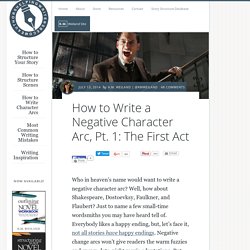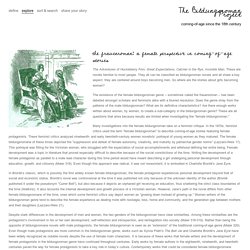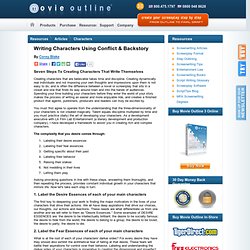

How to Manipulate a Protagonist's Likability Using Narrative Distance. Writing likable characters isn’t always the goal of a writer.

Characters are catalysts; they serve many different functions, and sometimes, a story requires readers to dislike a character. Although writing a likable protagonist can help readers sympathize and remain engaged, it’s not always necessary. Sometimes, it is simply more powerful to write a character who is not likable, particularly if you’re trying to illustrate the dangers of a traditionally negative quality, such as greed.
Remember: “protagonist” does not always mean “good guy.” The guest post is Jes Gonzalez. When Gonzalez isn’t conjuring or maintaining sentences, she’s devouring them, always hungry for more words. The Emotion Roller Coaster: Why Characters Resist Change - WRITERS HELPING WRITERS. I’m reading this fascinating book right now about the human brain (yes, really!)

That details how our gray matter works, and how we can evolve ourselves through concentrated intention and awareness. One of the terrific nuggets is the belief that every emotion, good or bad, sends a flood of chemicals through the body, and that repeated “doses” of this cocktail turns our brain into a bit of an addict, making it hard to break an emotional habit should we wish to. What does this mean? Well, if you are trying to claw past feelings of low self-worth brought on by past trauma, or you’re determined to think positively and fight the cloud of pessimism that always seems to envelope you, your brain may actually work against you. Creating Stunning Character Arcs, Pt. 1: Can You Structure Characters? How to Write Character Arcs. How to Write a Negative Character Arc, Pt. 1: The First Act. Who in heaven’s name would want to write a negative character arc?

Well, how about Shakespeare, Dostoevksy, Faulkner, and Flaubert? Just to name a few small-time wordsmiths you may have heard tell of. Everybody likes a happy ending, but, let’s face it, not all stories have happy endings. Negative change arcs won’t give readers the warm fuzzies and spawn date-night movie adaptations. But they do have the ability to create stories of unparalleled power and resonance—if they’re true. Truth resonates whether it’s happy or hard, and some of the hardest truths to swallow are the most important for any of us to understand.
How to “Fix” Unlikable Characters. Craft of Writing: Make Your Hero Complex By Choosing The Right Flaws by Angela Ackerman. Today we have an author and fellow blogger whose award winning writing resource website, Writers Helping Writers (formerly known as The Bookshelf Muse) with us with some incredibly helpful tips about character development.

Please welcome Angela Ackerman! The best characters are those who mirror real people, ones who are complex individuals with a blend of strengths, failings, talents and flaws. Of these four components, flaws can often be the most difficult to figure out, because knowing which negative traits will emerge means digging into a character’s past to understand what negative influences and experiences helped shaped them, and what painful emotional wounds they bear as a result. Flaws are unique because many form under the guise of “helping” a person.
On the outside, they seem to protect in some way, keeping the character from re-experiencing a deep emotional pain that happened in his past (the character’s wound). 2) Poke Your Character’s Wounds Past hurts leave a mark. 35 Weird Traits Your Characters May Have. The female bildungsroman — The Bildungsroman Project. The frauenroman: a female perspective in coming-of-age stories The Adventures of Huckleberry Finn, Great Expectations, Catcher in the Rye, Invisible Man.

Best fictional characters from Sherlock Holmes to Jane Eyre as chosen by 100 literary figures - Features - Books - The Independent. Everyone who enjoys reading, and even those who do not, have a favourite literary character.

From childhood staples such as William Brown and Paddington Bear to classic heroes and heroines like Charlotte Bronte's Jane Eyre and Jane Austen's Elizabeth Bennet, these figures have resided in our imagination for years and in some cases centuries. One hundred people connected with literature, including writers, directors and publishers, were asked to nominate their favourite fictional creation. Some choices were more surprising than others - author Pauline McLynn chose evil killing machine Hannibel Lecter and said he could eat her kidneys "as long as he fed me an excellent bottle of red wine beforehand". Each to their own. Lajos%20Egri%20-%20Notes.pdf. 3 Types of Character Arcs: Choose the Best for Your Novel.
How Does Your Character Change?

You know your character must change somehow over the course of your novel. But how? And more than that, how do you sync the changes with the external plot? The middle of a novel can suffer from the dreaded “sagging middle” and it’s mainly because you don’t have a firm handle on the character’s inner arc and how it meshes with external events.
When Flaws Go Too Far: Avoiding Unlikeable Characters. Writing Characters Using Conflict & Backstory. Seven Steps To Creating Characters That Write Themselves Creating characters that are believable takes time and discipline.

Avoiding Awkward (or Unnecessary) Internal Questions. By Janice Hardy, @Janice_Hardy The Q&A continues today with...

Q: When writing in third person, it reads awkward to internalize the MC's questions. At a conference, agents said just tell the reader...don't put in awkward questions. 11 Secrets to Writing Effective Character Description. The following is an excerpt from Word Painting Revised Edition by Rebecca McClanahan, available now!

The characters in our stories, songs, poems, and essays embody our writing. They are our words made flesh. Sometimes they even speak for us, carrying much of the burden of plot, theme, mood, idea, and emotion. But they do not exist until we describe them on the page. Welcome to Fuck Yeah Character Development. Creating Characters. The most fashionable characters in literature. How we wish we could dress like Holly. Elegant and chic with that black dress and pearl choker. Truman Capote clearly has taste. “She was still on the stairs, now she reached the landing, and the ragbag colors of her boy’s hair, tawny streaks, strands of albino blond and yellow caught the hall light. It was a warm evening, nearly summer, and she wore a slim, cool black dress, black sandals, a pearl choker. 10 Secrets to Creating Unforgettable Supporting Characters.
6 Ways to Write Better Bad Guys. Thirty Question Character Survey. 25 Things You Should Know About Character. Previous iterations of the “25 Things” series: 25 Things Every Writer Should Know. Msgyuhba6q1sr9i3ho1_500.jpg (500×669) Questionnaires for Writing Character Profiles. Enter your e-mail to get the e-book for FREE. We'll also keep you informed about interesting website news. "I have searched the web and used different worksheets, but none have come close to your worksheets and descriptions of (what to do and what not to do). Both courses I have taken have with Creative Writing Now have been amazing. Each time I have learned something new. The one thing I love, you take everything apart and give examples.
" - Katlen Skye "As usual - I already love the course on Irresistible Fiction, rewriting a lot and improving greatly even after the first lesson. “Essentials of Fiction proved that I could indeed write and I wrote every day, much to my boyfriend's dismay (waa sniff).” - Jill Gardner "I am loving the course and the peer interaction on the blog is fantastic!!! " "I'm enjoying the weekly email course, Essentials of Poetry Writing. "Thank you for all the material in this course. How to Create an Antihero That Readers Love. When Flaws Go Too Far: Avoiding Unlikeable Characters.
How to Pick Character Names: The 7 Rules of Choosing Names for Fictional Characters. Choosing a character name for your novel is as pressure-filled as picking a name for a baby. It has to suit the character’s personality, makes sense for the era and, most important, be super awesome (sorry friends, the awesome name of Brian A. Klems is already taken by this guy). Names like Harry Potter, Holden Caulfield and Stephanie Plum are memorable not just because of the amazing stories they navigate, but also because these names “fit” those characters so well. You need a name that “fits” your character too. I stumbled upon these seven great rules for choosing character names offered up by popular mystery writer Elizabeth Sims (the Rita Farmer Mysteries). Psychologists Discover How People Subconsciously Become Their Favorite Fictional Characters.
Psychologists have discovered that while reading a book or story, people are prone to subconsciously adopt their behavior, thoughts, beliefs and internal responses to that of fictional characters as if they were their own. Experts have dubbed this subconscious phenomenon ‘experience-taking,’ where people actually change their own behaviors and thoughts to match those of a fictional character that they can identify with. Researcher from the Ohio State University conducted a series of six different experiments on about 500 participants, reporting in the Journal of Personality and Social Psychology, found that in the right situations, ‘experience-taking,’ may lead to temporary real world changes in the lives of readers.
They found that stories written in the first-person can temporarily transform the way readers view the world, themselves and other social groups. "Experience-taking is much more immersive -- you've replaced yourself with the other," Libby said in a statement. Avoid Overactive or Inactive Supporting Characters When Writing A Novel. One of the most common plot problems writers face is mistaking minor characters and subplots for the main character and primary plot. 3 Steps to Writing a Novel with Unforgettable Characters. Character development is one of the first essential steps of writing a novel and it involves creating the people who will carry out your story. 8 Ways to Write Better Characters.
Seven Common Character Types. 7 Essential Elements of Character Creation. NamePlayground.com - the playground of first names - New! 2006 Name Statistics! It's Not What They Say... Interviewing Characters: Follow the Energy - Conversations with Dale. On November 13, 2007 I ran out of plot for the NaNoWriMo novel I was writing. I had no idea what to write next. Using Psychology in writing. The 100 Most Important Things To Know About Your Character (revised)
I don't tell lies, I write fiction with my mouth!, Character Sheets and character creation. Character Questionnaires - Get to Know Your Characters. 200 Word Descriptive Hair List. 6 Ways to Make Sure Your Reader’s Brain Syncs with Your Protagonist’s Brain. Random Name Generator. 13 ways to create compelling characters. Basic Tips To Avoid Tokenism. 123 Ideas for Character Flaws) 100 Character Development Questions for Writers - Gather.com : Gather.com. How to Write Character Arcs. 25 Ways To Fuck With Your Characters - StumbleUpon.
Second Fiddle, Sweeter Music—Using Secondary Characters To Give Your Novel A Bigger Feel. 5 Common Myths about Emotions — Guest: Kassandra Lamb.